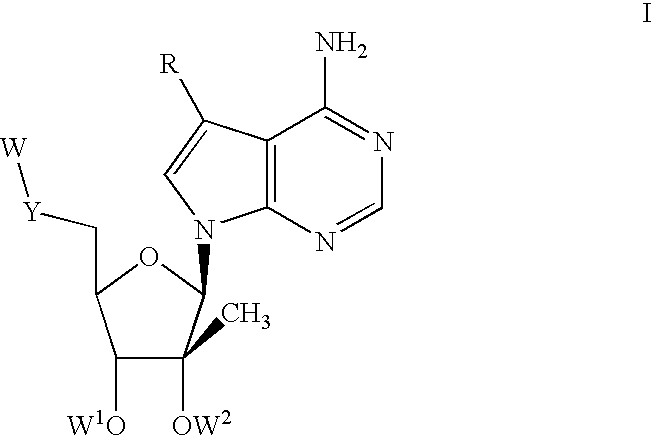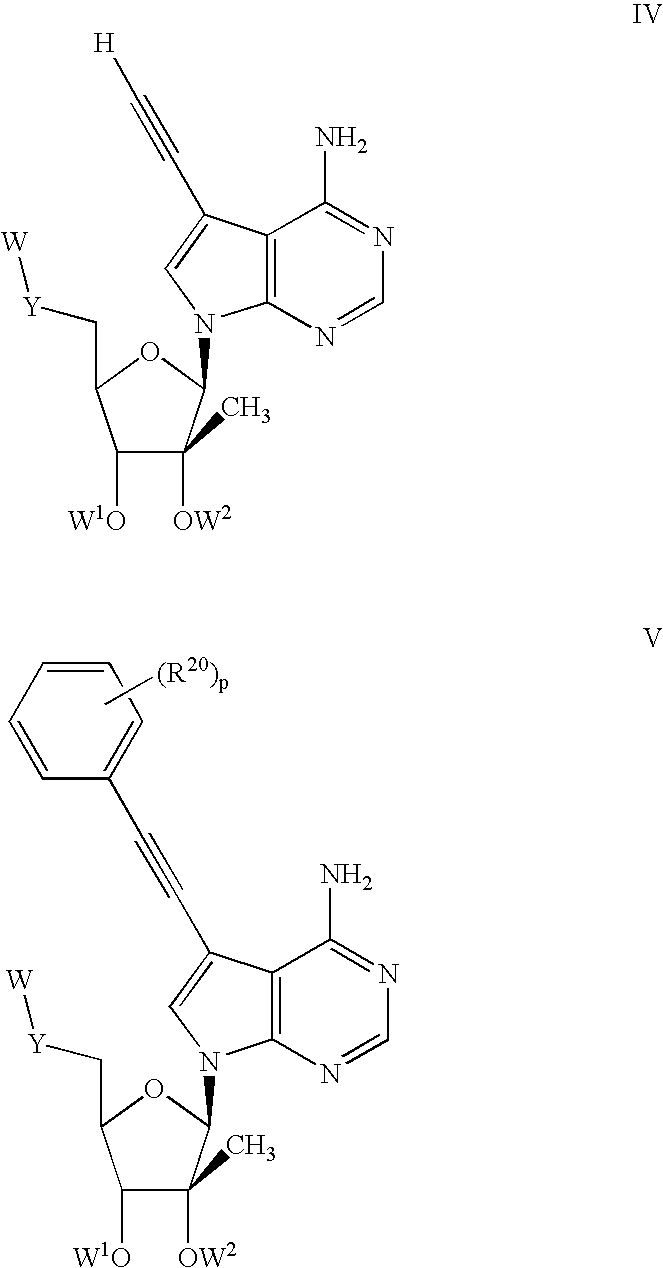Nucleoside compounds for treating viral infections
a technology of nucleoside compounds and viral infections, applied in the field of pharmaceutical chemistry, can solve the problems of no antiviral pharmaceutical drugs to prevent or treat pestivirus or flavivirus infections, and considerable pestivirus exposur
- Summary
- Abstract
- Description
- Claims
- Application Information
AI Technical Summary
Benefits of technology
Problems solved by technology
Method used
Image
Examples
example 6
Preparation of 7-(2′-C-methyl-β-D-ribofuranosyl)-4-amino-5-(2-cis-methoxyethen-1-yl-pyrrolo[2,3-d]pyrimidine
[0203]
Step 1: Preparation of 7-(2′-C-methyl-β-D-ribofuranosyl)-4-amino-5-(formyl)-pyrrolo[2,3-d]pyrimidine
[0204] 7-(2′-C-methyl-β-D-ribofuranosyl)-4-amino-5-(formyl)-pyrrolo[2,3-d]pyrimidine was synthesized according to the procedure described by Shin-ichi Watanabe and Tohru Ueda in Nucleosides and Nucleotides (1983) 2(2), 113-125. In the synthesis of the title compound however, 7-(2′-C-methyl-β-D-ribofuranosyl)-4-amino-pyrrolo[2,3-d]pyrimidine (See Carroll, et al., 11,12) was substituted in place of tubercidin.
[0205] H1-NMR (CD3OD): 0.9 (s, 3H, 2′-CH3), 3.8-4.2 (m, 4H, sugar), 6.3 (s, 1H, 1′-H), 8.2 and 8.6 (s, 1H, —Ar), 9.7 (s, 1H, -aldehyde-H). MS: 309.13 (M+H).
Step 2: Preparation of the Title Compound
[0206] The product from Step 1 above (0.050 g, 0.162 mmol) was dissolved in 2 mL DMSO and added dropwise to the preformed ylide of (methoxymethyl)-triphenylphosphonium ch...
example 7
Preparation of 7-(2′-C-methyl-β-D-ribofuranosyl)-4-amino-5-(ethen-1-yl)-pyrrolo[2,3-d]pyrimidine
[0208]
[0209] The title compound from Example 2 (0.040 g, 0.0132 mmol) was dissolved in 3 mL THF and 22 mg of Lindlar's catalyst was added. The solution was stirred at ambient temperature under 1 atm of hydrogen (via balloon) for 7 days. The balloon was recharged with hydrogen at the beginning of each day. After 7 days, the reaction was filtered through celite to remove catalyst, concentrated in vacuo, and purified by reverse phase HPLC on Phenominex column (250×20 mm) using a gradient of acetonitrile in water from 0 to 30% over 30 min at 10 mL / min to yield 30 mg (75% yield) of the title compound.
[0210] H1-NMR (CD3OD): 0.835 (s, 3H, 2′-CH3), 3.8-4.2 (m, 4H, sugar), 5.2 (dd, 1H), 5.5 (dd, 1H), 6.23 (s, 1H, 1′-H), 6.9 ((dd, 1H), 7.73 and 8.06 (s, 1H, —Ar). MS: 307.15 (M+H).
example 8
General Preparation of Nucleoside Triphosphates
[0211] An appropriately substituted 7-(β-D-ribofuranosyl)-pyrrolo[2,3-d]pyrimidine (0.1 mmol) was co-evaporated 3 times with dry DMF, dissolved in 2 mL of PO(OMe)3, cool to 5° C. and POCl3 (35 μL) and proton sponge (64 mg) were added. The mixture was stirred at 5° C. for 3 h, then tetrabutylammonium pyrophosphate (2 mmol, 4 mL of 0.5M solution in DMF) was added and the mixture was kept for 2 more h at the same temperature. The reaction was quenched with (Et3N)HCO3 buffer (pH 7.5) followed with water. The solvents were evaporated, the residue dissolved in methanol (3 mL) and precipitated with ether (30 mL). The solid residue was purified by IE HPLC on Vidac column (250×10 mm) 0 to 100% B. Buffer A was 25 mM NaH2PO4 / Na2HPO4, pH 3, buffer B was 310 mM NaH2PO4 / Na2HPO4, pH 3. The last peak was collected, concentrated up to the volume of 5 mL and repurified on RP HPLC on Phenominex column (250×20 mm) in gradient from 0 to 100% of buffer B in...
PUM
| Property | Measurement | Unit |
|---|---|---|
| Composition | aaaaa | aaaaa |
| Antimicrobial properties | aaaaa | aaaaa |
Abstract
Description
Claims
Application Information
 Login to View More
Login to View More - R&D
- Intellectual Property
- Life Sciences
- Materials
- Tech Scout
- Unparalleled Data Quality
- Higher Quality Content
- 60% Fewer Hallucinations
Browse by: Latest US Patents, China's latest patents, Technical Efficacy Thesaurus, Application Domain, Technology Topic, Popular Technical Reports.
© 2025 PatSnap. All rights reserved.Legal|Privacy policy|Modern Slavery Act Transparency Statement|Sitemap|About US| Contact US: help@patsnap.com



